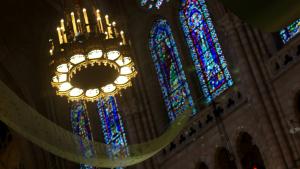When they teach us to plan worship and preach in seminary one of the first skills we learn is how to use the historical-critical method to exegete the text we’re working with. That sounds very complicated, but what it essentially means is this: before creating liturgy and proclamation we look at the biblical text from several different angles to make sure we understand the history, context, language, theology, and meaning of the text. This is important, as you know, because it’s easy to use the Bible to say pretty much anything you want. Exegesis keeps us true to the intended meaning of the text.
For the next three weeks as we do the Work of Worship, we’ll be trying to open up the different parts of our worship experience to show you why and how we plan for, prepare, and deliver a worship experience. As we do every Sunday, in just a moment we’ll hear the gospel text for the week, which also happens to be the foundational text for the sermon today. To let you in on a little background, before I read it I want to share some exegesis with you.
Our gospel passage today is Matthew’s version of a familiar story: the baptism of Jesus. There are four gospels in the New Testament: different versions of the story of Jesus’ life. Three of them: Matthew, Mark, and Luke, tell the story of Jesus’ baptism.
 Matthew’s version of the story is a bit more brief than the others: basically, Jesus goes to his cousin John, who was a kind of itinerate preacher, and asks him to be baptized in the Jordan River, as many other people were doing in those days. John doesn’t want to do it—who is he to baptize Jesus? But John goes ahead, and when Jesus comes up out of the water, the heavens open, a dove comes down, and the Jesus hears God’s voice calling Jesus a beloved child of God. Most New Testament scholars agree that this language is a quotation or reflection of the first verse of chapter 42 of Isaiah that reads, “Here is my servant, whom I uphold, my chosen, in whom my soul delights; I have put my spirit upon him; he will bring forth justice to the nations.”
Matthew’s version of the story is a bit more brief than the others: basically, Jesus goes to his cousin John, who was a kind of itinerate preacher, and asks him to be baptized in the Jordan River, as many other people were doing in those days. John doesn’t want to do it—who is he to baptize Jesus? But John goes ahead, and when Jesus comes up out of the water, the heavens open, a dove comes down, and the Jesus hears God’s voice calling Jesus a beloved child of God. Most New Testament scholars agree that this language is a quotation or reflection of the first verse of chapter 42 of Isaiah that reads, “Here is my servant, whom I uphold, my chosen, in whom my soul delights; I have put my spirit upon him; he will bring forth justice to the nations.”
An important question to ask when reading this text is: why would Jesus need to be baptized? Matthew’s gospel was written near the end of the first century and it wasn’t until the fourth century that Christians got to arguing about whether Jesus was human or divine or some combination of the both. In other words, Jesus didn’t really need the endorsement, so the reader might wonder why he did it and even why Matthew, Mark, and Luke felt it was important enough to include in their accounts of Jesus’ life.
Another important detail to notice in this passage is that the crowd doesn’t hear God’s voice or see the dove come down from heaven. The text says, “the heavens were opened to him.” Was this a private moment for Jesus?
This incident occurs just as Jesus was beginning his ministry—preaching a message of radical love that flew in the face both of the corrupt Roman occupation and also the religious machinery of the Temple. Careful exegesis might lead us to conclude that what we are witnessing here is a moment when Jesus was facing doubt or fear, when he needed to gather resolve or courage for the work ahead of him, when he needed most of all to remember who he was.
Listen carefully to the reading of the gospel as we do the Work of Worship together:
Matthew 3:13-17
3:13 Then Jesus came from Galilee to John at the Jordan, to be baptized by him.
3:14 John would have prevented him, saying, “I need to be baptized by you, and do you come to me?”
3:15 But Jesus answered him, “Let it be so now; for it is proper for us in this way to fulfill all righteousness.” Then he consented.
3:16 And when Jesus had been baptized, just as he came up from the water, suddenly the heavens were opened to him and he saw the Spirit of God descending like a dove and alighting on him.
3:17 And a voice from heaven said, “This is my Son, the Beloved, with whom I am well pleased.”












